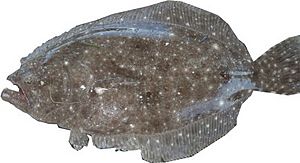Gulf flounder facts for kids
Quick facts for kids Gulf flounder |
|
|---|---|
 |
|
| Conservation status | |
| Scientific classification |
The Gulf flounder (Paralichthys albiguttata) is a type of saltwater flounder. It's a fascinating flatfish that swims on its side! You can find them in the western North Atlantic Ocean, especially along the coast of Florida.
Contents
About the Gulf Flounder
The Gulf flounder is a special kind of flatfish. It swims sideways, and both of its eyes are on one side of its head, looking upwards! They also have sharp teeth. One side of their body is white.
These fish live for about 7 to 10 years. Female flounders can start having babies when they are 1 to 2 years old. People often catch Gulf flounders for food and fun. You'll find many of them along the northeastern coast of Florida.
Where They Live
Gulf flounders live in shallow waters near the coast, like in estuaries (where rivers meet the sea) and along the shoreline. They are usually found on the ocean floor, from about 18 to 92 meters deep. Sometimes, they can be found even deeper, up to 130 meters.
They like different places to live, including areas with seagrass beds, coastal lagoons, and flat, sandy bottoms. Young flounders often hide in seagrass beds. As they get older, they move to deeper waters offshore.
Life Cycle and Diet
Gulf flounders change what they eat as they grow. When they are small, they munch on tiny crustaceans, like amphipods. But as they get bigger, they mostly eat other fish.
Adult flounders spend most of the year in bays and estuaries. When it's time to lay eggs, usually from late October to mid-December, they swim out to deeper offshore waters. The young larvae (baby fish) then swim back towards the shore in January and February.
Female flounders grow faster and bigger than males. Females can live for about 7 years, while males can live a bit longer, around 8 to 11 years.
Fishing for Flounder
Gulf flounders are popular sport fish. People enjoy catching them! You can catch them using dead fish like mullet, live bait, or even frozen baits like shrimp or clams. Some common ways to catch them are by spearfishing or using a jig (a type of fishing lure).
For recreational fishing, there's a daily limit of 10 flounders per person. The fish must be at least 12 inches long to be kept. Commercial fishermen are allowed to catch up to 50 pounds of flounder as part of their other catches.
These fish are important for both sport and commercial fishing because they are a tasty food fish. They are caught using different methods, including trawling, gill nets, gigs, hook-and-line, and trammel nets.
Threats to Flounder
The Gulf flounder is an important fish for both commercial fishing and recreational fishing, especially in Florida. However, they face some challenges.
One big problem is that they can be caught by accident in large fishing nets, especially those used to catch shrimp. Also, the places where they live, like seagrass beds, have been shrinking over the years. Seagrass beds are important nurseries and homes for young flounders.
Another threat is the Lionfish, which is an invasive species. Lionfish eat many native fish, including the Gulf flounder.
See also
 In Spanish: Platija del Golfo para niños
In Spanish: Platija del Golfo para niños


